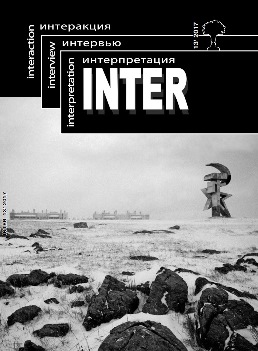Эпистемологические предпосылки конвертации видео социальных событий в нарратив
Для цитирования
Баньковская С. Эпистемологические предпосылки конвертации видео социальных событий в нарратив // Интеракция. Интервью. Интерпретация. 2017. Том 9. № 13. С. 39-43.
Аннотация
Как сконструировать нарративы видеофайлов? Можем ли мы обозначить некоторые общие требования к различным нарративам о структуре видео? Оба эти вопроса неизбежны для теоретически-ориентированного исследования, основанного на видео-методологии, и по-прежнему открыты для рефлексивного осмысления. В целом, использование видео как данных служит проверкой и верификацией наших ограниченных интуиций и воспоминаний; они предоставляют наблюдателю широкий спектр материалов как данных, а также служат подтверждением того, что аналитические размышления и «результаты» не возникают из артефактов интуитивной идиосинкразии, селективного внимания или памяти, или как результат полевого эксперимента. Необходимость проникновения в текст требует от социологов фокусировки не только на лингвистических проблемах. Для того, чтобы быть индексальным в работе с исследовательскими данными, предполагается, что социологи должны быть не только открыты к напрямую связанным субъектам, но также следовать на практике «абсолютно адекватному методу» и «безразличию» по отношению к междисциплинарным барьерам.
Ключевые слова:
Эпистемология, видеоанализ, нарратив, методология,
Литература
Back, L., Puwar, N. (eds.) 2013. Live Methods. Oxford: Wiley-Blackwell.
Bankovskaya, S., Filippov, A. 2015. Narrative in the Micro-analysis of Visual Anthropology and Ethnomethodology
Data: Working Out the Methods’ Framework for the Study of Social Events. Unpublished
manuscript.
Bauman, Z. 1990. Thinking Sociologically. L.: Polity.
Harper, D. 2002. Talking about pictures case for photo elicitation. Visual Studies, 17: 14–26.
Heath, C., Hindmarsh, J., Luff, P. (eds.) 2010. Video in Qualitative Research: Analyzing Social Interaction
in Everyday Life. London: SAGE.
Heritage, J. 2011. A Galilean Moment in Social Theory? Language, Culture and their Emergent Properties.
Qualitative Sociology, 34: 263–70.
Lorimer, H. 2005. Cultural Geography: the busyness of being «more-than-representational». Progress
in Human Geography, 29(1): 83–94.
Pink, S. 2012. Advances in Visual Methodology. London: Sage.
Prosser, J. (ed.) 1998. Image-based Research: A Sourcebook for Qualitative Researchers. London: RoutledgeFalmer.
Ricoeur, P. 1976. Interpretation Theory: Discourse and the Surplus of Meaning. Fort Worth: The Texas
Christian University Press.
Ricoeur, P. 2008. From Text to Action: Essays in Hermeneutics II. London: Bloomsbury Publishing.
Rubi, J. 2000. Picturing Culture. Chicago: University of Chicago Press.
Simpson, P. 2015. Atmospheres of Arrival/Departure and Multi-Angle Video Recording: Reflections
from St Pancras and Gare du Nord. Video Methods. Social Science Research in Motion/ Ed.by Ch. Bates.
New York: Rutledge. Р. 27–48.
Vannini, P. (ed.) 2014. Non-Representational Methodologies. New York: Routledge.
Bankovskaya, S., Filippov, A. 2015. Narrative in the Micro-analysis of Visual Anthropology and Ethnomethodology
Data: Working Out the Methods’ Framework for the Study of Social Events. Unpublished
manuscript.
Bauman, Z. 1990. Thinking Sociologically. L.: Polity.
Harper, D. 2002. Talking about pictures case for photo elicitation. Visual Studies, 17: 14–26.
Heath, C., Hindmarsh, J., Luff, P. (eds.) 2010. Video in Qualitative Research: Analyzing Social Interaction
in Everyday Life. London: SAGE.
Heritage, J. 2011. A Galilean Moment in Social Theory? Language, Culture and their Emergent Properties.
Qualitative Sociology, 34: 263–70.
Lorimer, H. 2005. Cultural Geography: the busyness of being «more-than-representational». Progress
in Human Geography, 29(1): 83–94.
Pink, S. 2012. Advances in Visual Methodology. London: Sage.
Prosser, J. (ed.) 1998. Image-based Research: A Sourcebook for Qualitative Researchers. London: RoutledgeFalmer.
Ricoeur, P. 1976. Interpretation Theory: Discourse and the Surplus of Meaning. Fort Worth: The Texas
Christian University Press.
Ricoeur, P. 2008. From Text to Action: Essays in Hermeneutics II. London: Bloomsbury Publishing.
Rubi, J. 2000. Picturing Culture. Chicago: University of Chicago Press.
Simpson, P. 2015. Atmospheres of Arrival/Departure and Multi-Angle Video Recording: Reflections
from St Pancras and Gare du Nord. Video Methods. Social Science Research in Motion/ Ed.by Ch. Bates.
New York: Rutledge. Р. 27–48.
Vannini, P. (ed.) 2014. Non-Representational Methodologies. New York: Routledge.
Форматы цитирования
Другие форматы цитирования:
APA
Баньковская, С. (2017). Эпистемологические предпосылки конвертации видео социальных событий в нарратив. Интеракция. Интервью. Интерпретация, 9(13), 39-43. извлечено от https://www.inter-fnisc.ru/index.php/inter/article/view/5375
Выпуск
Раздел
Теоретические дискурсы и дискуссии











